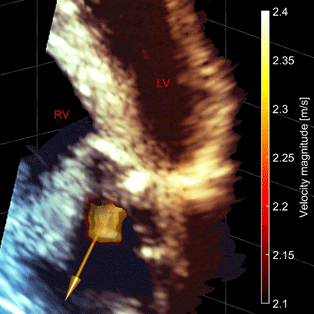Aortic valve stenosis is a narrowing of the valve that separates the left ventricle from the aorta. A reduced opening increases the effort required by the left ventricle to pump blood. Being a degenerative disease, patients with aortic stenosis must undergo a clinical follow-up, which is usually performed by ultrasound. At the Centre of Innovative Ultrasound Solutions (CIUS), we are developing a new method that exploits 3-D high frame-rate imaging to increase the degree of automation in aortic stenosis flow measurements. The goal is to speed up the workflow in the clinics and increase the accuracy of measurements.
@NTNUhealth
-
How do you check that a petroleum well is leak-proof, so that it cannot endanger the environment or the platform staff? To do so, you’d have to investigate a narrow hole with a diameter of maybe 30 cm, kilometers below the ground, where the temperatures can reach well above 100°C and the pressure is crushing. This may sound difficult, and it is! Even so, the petroleum industry has been doing things like these for almost a century, and over the past four decades they have increasingly been using ultrasonic techniques.
-
GeneticsNTNUhealthPublic HealthResearch
Using HUNT to study disease-causing genetic variation
by @NTNUhealth 5 September 2018Using HUNT data, researchers are implementing statistical methods to discover disease-causing genetic variants.
-
NTNUhealth
Health Challenges in a Syrian refugee settlement in Lebanon
by @NTNUhealth 31 August 2018What challenges do Syrian refugees meet? And how can they be resolved with limited resources? These were some of the questions we had to deal with at the summer school in Beirut that I took part in.
By Anne Christine Abrahamsen, Masterstudent in Global Health.
-
CardiovascularNTNUhealth
Improving cardiac ultrasound in difficult-to-image patients
by @NTNUhealth 30 August 2018Despite constant improvements within the field of medical ultrasound, there are still a considerable number of difficult-to-image patient. Echocardiograms (heart images) taken from these patients do not have the quality that is needed for correct diagnosis. Therefore it is important to further improve the quality of echocardiograms.
-
Children and youthNTNUhealthPublic Health
How environmental toxins can pose risk to children’s development – A Faroese case study
by @NTNUhealth 15 August 2018Humans are in constant interaction with our environments. New research is shedding light on how our environment shapes our health starting early in life and the developmental origins of health and disease (known as DOHaD). One area of global concern is the risks on children’s development posed by environmental toxins, such as heavy metals, air pollution, pesticides, and other pollutants.
-
Researchers discovered over 140 genetic changes associated with atrial fibrillation, a common, adult-onset cardiac arrhythmia. The results were surprising in that they also identified a number of genes that control heart development in the fetus.
-
CardiovascularNTNUhealth
Could your local doctor diagnose heart disease using a handheld ultrasound device?
by @NTNUhealth 29 June 2018Many potential heart patients that are referred to specialists, turn out not to need specialist care. If general practitioners (GPs) could use handheld ultrasound devices with built-in diagnostic tools, could this improve patient outcome and reduce cost for the health services?
-
CardiovascularNTNUhealth
Improving ultrasound images of the heart’s blood vessels
by @NTNUhealth 20 June 2018Coronary heart disease is a condition where the heart muscle (myocardium) does not receive enough oxygen and nutrients due to obstruction of blood flow in the heart’s blood vessels, known as the coronary arteries. It is therefore important to investigate the blood flow in these vessels. However, it is challenging to obtain accurate measurements due to the combination of poor blood flow, the constant movement of the heart throughout the cardiac cycle, and surrounding tissue causing noise signals.
-
In the world today, there are five billion people who don’t have the access to timely, safe, and affordable surgery. Most of these people lives where there is a shortage of health personnel in general. To give a picture of the shortage of surgical personnel; in the poorest but also the most populated part of the world like East Africa you can find only 0,53 surgeons per 100.000 population.
By Iril Naustdal, Master Student in Global Health

